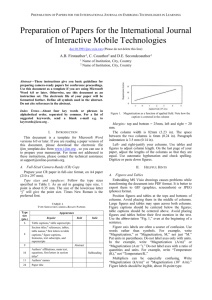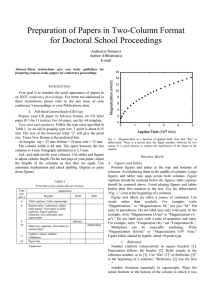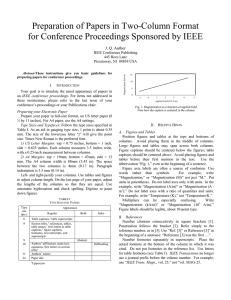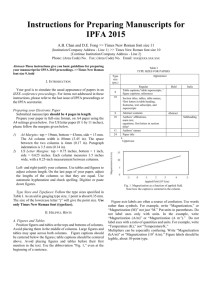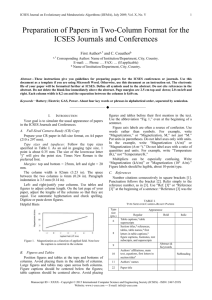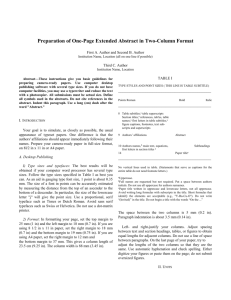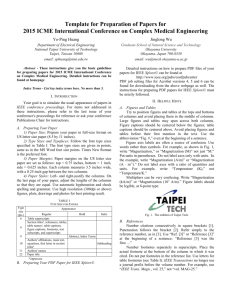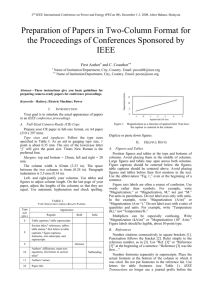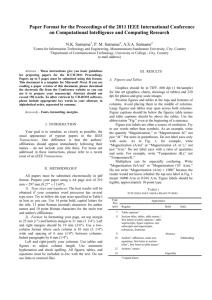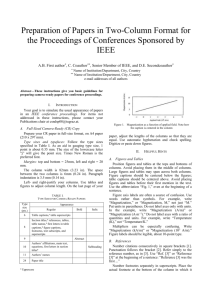IJCEE Paper Template - World Academy of Research and Publication
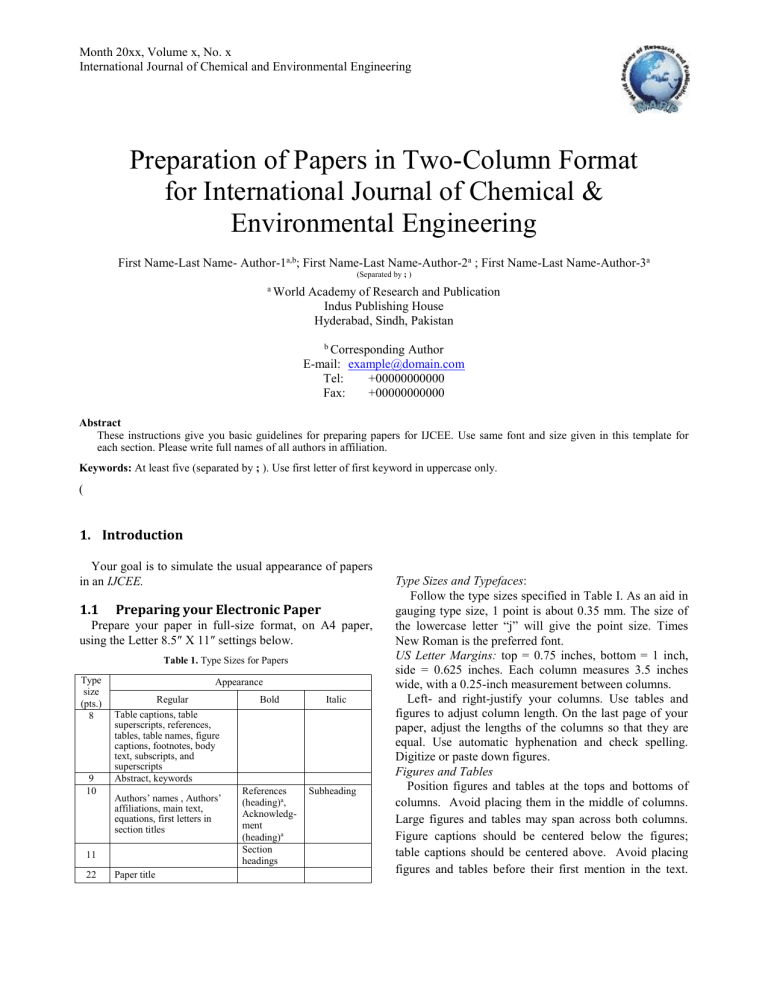
(
Month 20xx, Volume x, No. x
International Journal of Chemical and Environmental Engineering
Preparation of Papers in Two-Column Format for International Journal of Chemical &
Environmental Engineering
First Name-Last Name- Author-1 a,b ; First Name-Last Name-Author-2 a ; First Name-Last Name-Author-3 a
(Separated by ; ) a World Academy of Research and Publication
Indus Publishing House
Hyderabad, Sindh, Pakistan b Corresponding Author
E-mail: example@domain.com
Tel: +00000000000
Fax: +00000000000
Abstract
These instructions give you basic guidelines for preparing papers for IJCEE. Use same font and size given in this template for each section. Please write full names of all authors in affiliation.
Keywords: At least five (separated by ; ). Use first letter of first keyword in uppercase only.
1.
Introduction
Your goal is to simulate the usual appearance of papers in an IJCEE.
1.1
Preparing your Electronic Paper
Prepare your paper in full-size format, on A4 paper, using the Letter 8.5″ X 11″ settings below.
Table 1. Type Sizes for Papers
Type
Appearance size
(pts.)
Regular
8 Table captions, table superscripts, references, tables, table names, figure
Bold captions, footnotes, body text, subscripts, and superscripts
9 Abstract, keywords
10
11
Authors’ names , Authors’ affiliations, main text, equations, first letters in section titles
References
(heading) a
,
Acknowledgment
(heading) a
Section headings
22 Paper title
Italic
Subheading
Type Sizes and Typefaces :
Follow the type sizes specified in Table I. As an aid in gauging type size, 1 point is about 0.35 mm. The size of the lowercase letter “j” will give the point size. Times
New Roman is the preferred font.
US Letter Margins: top = 0.75 inches, bottom = 1 inch, side = 0.625 inches. Each column measures 3.5 inches wide, with a 0.25-inch measurement between columns.
Left- and right-justify your columns. Use tables and figures to adjust column length. On the last page of your paper, adjust the lengths of the columns so that they are equal. Use automatic hyphenation and check spelling.
Digitize or paste down figures.
Figures and Tables
Position figures and tables at the tops and bottoms of columns. Avoid placing them in the middle of columns.
Large figures and tables may span across both columns.
Figure captions should be centered below the figures; table captions should be centered above. Avoid placing figures and tables before their first mention in the text.
Preparation of Papers in Two-Column Format for International Journal of Chemical & Environmental Engineering
Use the abbreviation “Fig. 1,” even at the beginning of a sentence.
Figure axis labels are often a source of confusion. Use words rather than symbols. For example, write
“Magnetization,” or “Magnetization (M)” not just “M.”
Put units in parentheses. Do not label axes only with units. In the example, write “Magnetization (A/m)” or
“Magnetization (A
m -1 ).” Do not label axes with a ratio of quantities and units. For example, write “Temperature
(K),” not “Temperature/K.”
Multipliers can be especially confusing. Write
“Magnetization (kA/m)” or “Magnetization (10 3 A/m).”
15
10
Abbreviations and Acronyms
Define abbreviations and acronyms the first time they are used in the text, even if they have been defined in the abstract. Abbreviations such as IEEE, SI, MKS, CGS, sc, dc, and rms do not have to be defined. Do not use abbreviations in the title unless they are unavoidable.
Equations
Number equations consecutively with equation numbers in parentheses flush with the right margin, as in
(1). To make your equations more compact, you may use the solidus ( / ), the exp function, or appropriate exponents. Italicize Roman symbols for quantities and variables, but not Greek symbols. Use an en dash (–) rather than a hyphen for a minus sign. Use parentheses to avoid ambiguities in denominators. Punctuate equations with commas or periods when they are part of a sentence,
5
0
-1 0 1 2 3
Applied Field (10 4 A/m)
4 5
Figure 1. Magnetization as a function of applied field.
Note how the caption is centered in the column. as in a + b = c . (1)
Symbols in your equation should be defined before the equation appears or immediately following. Use “(1),” not
“Eq. (1)” or “equation (1),” except at the beginning of a sentence: “Equation (1) is …”
References
Other Recommendations
Number citations consecutively in square brackets [1].
Punctuation follows the bracket [2]. Refer simply to the reference number, as in [3]…... Use “Ref. [3]” or
Reference [3]” at the beginning of a sentence: “Reference
[3] was the first …”
Number footnotes separately in superscripts. Place the actual footnote at the bottom of the column in which it was cited. Do not put footnotes in the reference list. Use letters for table footnotes (see Table I).
Give all authors’ names; use “et al.” if there are six authors or more. Papers that have not been published, even if they have been submitted for publication, should be cited as “unpublished” [4]. Papers that have been accepted for publication should be cited as “in press” [5].
In a paper title, capitalize the first word and all other words except for conjunctions, prepositions less than seven letters, and prepositional phrases.
For papers published in translated journals, first give the English citation, then the original foreign-language citation [6].
Standard IJCEE Reference style for Endnote is available for download at: http://warponline.org/journals.htm
Do not number A CKNOWLEDGMENT and R EFERENCES , and begin Subheadings with letters. Use single space after periods (full stops). Hyphenate complex modifiers:
“zero-field-cooled magnetization.” Avoid dangling participles, such as, “Using (1), the potential was calculated.” Write instead, “The potential was calculated using (1),” or “Using (1), we calculated the potential.”
Use a zero before decimal points: “0.25,” not “.25.”
Use “cm 3 ,” not “cc.” Do not mix complete spellings and abbreviations of units: “Wb/m 2 ” or “webers per square meter,” not “webers/m 2 .” Spell units when they appear in text: “a few henries,” not “a few H.” Do not add page numbers.
Use either SI (MKS) or CGS as primary units. (SI units are encouraged.) English units may be used as secondary units (in parentheses). An exception would be the use of
English units as identifiers in trade, such as “3.5-inch disk drive.”
Avoid combining SI and CGS units, such as current in amperes and magnetic field in oersteds. This often leads to confusion because equations do not balance dimensionally. If you must use mixed units, clearly state the units for each quantity that you use in an equation.
Some Common Mistakes
The word “data” is plural, not singular. The subscript for the permeability of vacuum
0
is zero, not a lowercase letter “o.” In American English, periods and commas are within quotation marks, like “this period.” A parenthetical statement at the end of a sentence is
8
Preparation of Papers in Two-Column Format for International Journal of Chemical & Environmental Engineering punctuated outside of the closing parenthesis (like this).
(A parenthetical sentence is punctuated within the parentheses.). A graph within a graph is an “inset,” not an
“insert.” The word alternatively is preferred to the word
“alternately” (unless you mean something that alternates).
Do not use the word “essentially” to mean
“approximately” or “effectively.” Be aware of the different meanings of the homophones “affect” and
“effect,” “complement” and “compliment,” “discreet” and
“discrete,” “principal” and “principle.” Do not confuse
“imply” and “infer.” The prefix “non” is not a word; it should be joined to the word it modifies, usually without a hyphen. There is no period after the “et” in the
Latin abbreviation “et al.” The abbreviation “i.e.” means
“that is,” and the abbreviation “e.g.” means “for example.” An excellent style manual for science writers is [7].
A CKNOWLEDGMENT
R EFERENCES
[1] Halvarsson, S., Edlund, H., & Norgren., M. Manufacture of nonresin wheat straw fibreboards . Industrial crops and products,
(2009). 29: 437-45.
[2] Bejan, A. Advanced engineering thermodynamics (2nd ed.).
(1997). New York: Wiley.
[3] Satyanarayana, K. G., Ramos, L. P., & Wypych, F. Development of new materials based on agro and industrial wastes towards ecofriendly society. In T. N. Ghosh, T. Chakrabarti & G. Tripathi
(Eds.), Biotechnology in energy management (583-624). New
Delhi, India: APH Publishing Corporation:2005.
[4] K. Elissa, “Title of paper if known,” unpublished.
[5] R. Nicole, “ Title of paper with only first word capitalized ,” J.
Name Stand. Abbrev ., in press.
[6] Y. Yorozu, M. Hirano, K. Oka, and Y. Tagawa, “Electron spectroscopy studies on magneto-optical media and plastic substrate interface,” IEEE Transl. J. Magn. Japan .(1987). 2:740-
741. [ Digests 9 th
Annual Conf. Magnetics Japan.
1982. 301].
[7] M. Young, The Technical Writer’s Handbook.
(1989). Mill Valley,
CA: University Science
The preferred spelling of the word “acknowledgment” in America is without an “e” after the “g.” Try to avoid the stilted expression, “One of us (R. B. G.) thanks …”
Instead, try “R.B.G. thanks …”. Put sponsor acknowledgments in the unnumbered footnote on the first page.
9

